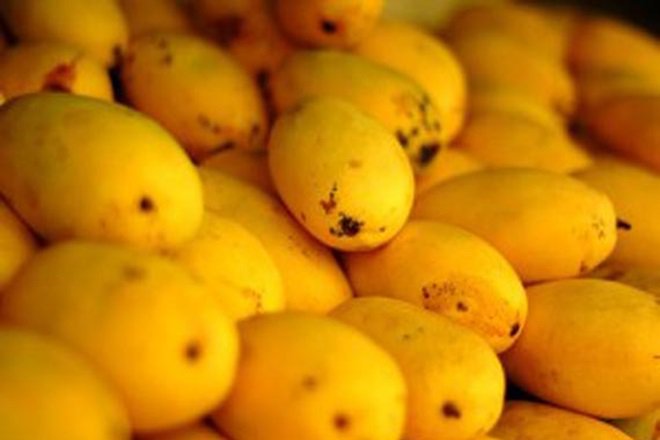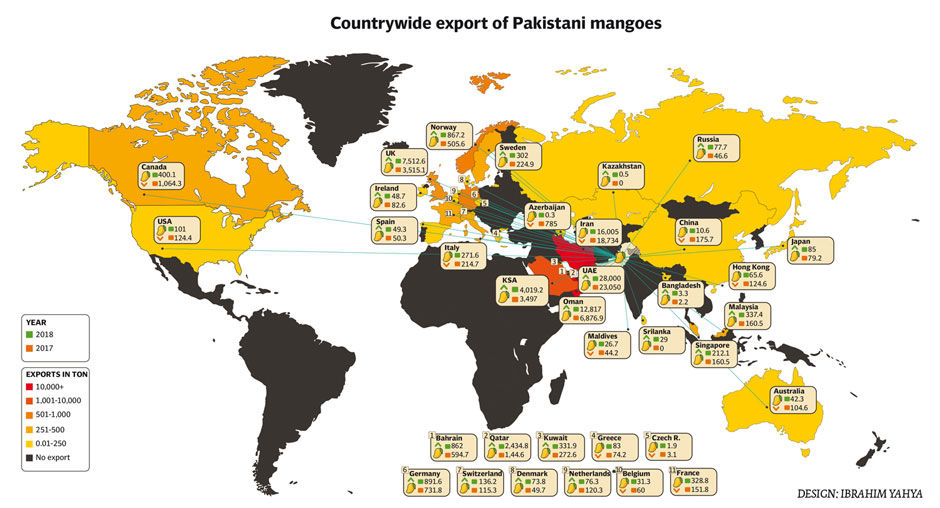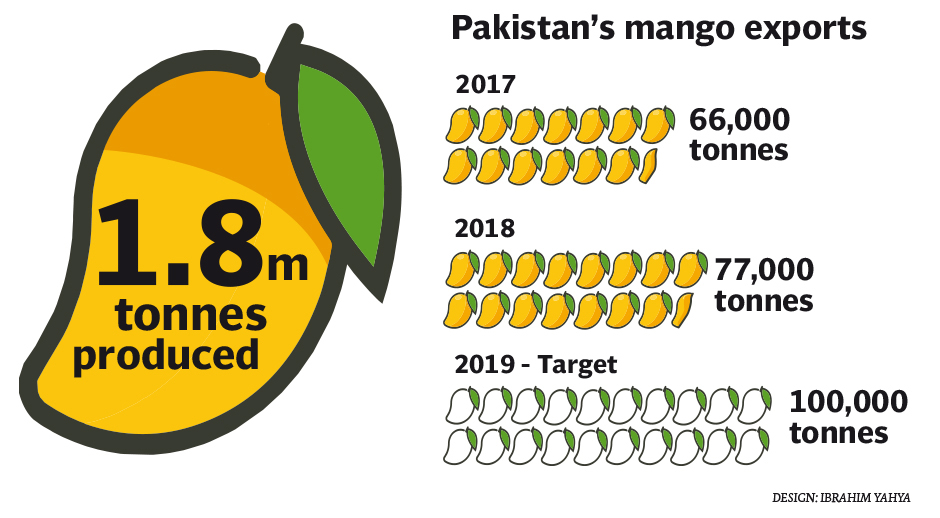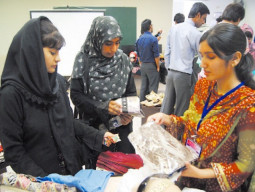
But what if the answer to all the troubles was not this complicated. What if all we had to do to put the country on the right path was to look to the 'King of Fruits' rather than 'friendly allies'. We are after all said to be an agriculture-based economy.
According to experts, Pakistan's horticulture sector has so much potential that if it is tapped, the country can be rid of international lenders.
In this context, The Express Tribune takes a look at mango, which is not just the national fruit of Pakistan, but also the second-most exported fruit grown in the country. Currently, the country's mango production stands at 1.8 million tonnes, of which around 6% is exported.
Mangoes quench Pakistan’s summer brunt
However, not only is there a need to enhance the current level of exports but attention should also be paid to the production of the fruit.

Widely cultivated in Sindh and Punjab provinces, the popular varieties of mangoes - Sindhri and Chaunsa - come from Tando Muhammad Khan and Badin, and Multan and Rahim Yar Khan respectively. Apart from these, other varieties available in the market include Langra, Dussehri and Anwar Ratole.
This pulpy summer fruit is not just a season favourite in Pakistan, in fact it is hailed as the 'King of Fruits' in the entire sub-continent. About three-fourth of the world's mangoes are produced in Asia and are much in demand due to their exceptional taste and versatility.
Rich in flavour, aroma and colour, mangoes have an interesting history that dates back centuries.
From Alexander to the Mughal emperors of the sub-continent, mango was the fruit of the royals. It is said that the obsessive love for mangoes was the only legacy that flowed from one generation to the next in the Mughal dynasty. In fact, during his rule, Akbar had planted over 100,000 mango trees.
This tradition of growing mangoes continued and as things stand Pakistan is the world's fourth largest producer. Heralding the arrival of summer, mangoes become available in the market from early May and remain till September.
Despite this, the country seems to have hit a roadblock because neither are we able to boost exports nor the area under cultivation, which is the need of the hour.
An official of the Ministry of Commerce told The Express Tribune that Pakistan produces around 1.75 million tons of mangoes each year. In the past, the country was able to export over 100,000 tons of mangoes during 2005-06 and 2012-13, which was around 6% of production.
However, the export capacity is a lot more than this, he stressed, adding that Pakistan has ample capacity but lacks capability to export mangoes in greater volumes.
Responding to a question as to why the country has been unable to boost exports, the official said over the past couple of years Pakistan has entered many new markets but unfortunately it has not been able to boost export of mangoes.
"Poor quality and lack of will/commitment on the part of exporters to deliver the quality demanded by the international market are some of the factors hindering the growth in mango exports," he said.
"Another factor responsible for lower exports has been low per-hectare yield ie higher per unit cost."
In its annual work plan for 2019-20, Pakistan Horticulture Development and Export Company (PHDEC) has included orchard management, cool chain and provision of heavy scanners at airports to cope with the above-mentioned issues, he added.
The ministry official also cited higher cost of Hot Water Treatment (HWT), poor packaging and higher air freight for different destinations as other factors.
He said whenever the international market tastes Pakistani mangoes, it loves the taste, aroma and sweetness but due to the look and appearance of Pakistani mangoes and low-quality packaging, the mangoes are considered B and even C quality.
"PHDEC recently organised a tasting event in China and while Chinese people liked the taste, they were not satisfied with the look, appearance and corresponding price of our mangoes versus others available from Thailand and from within the country."
The official said in order to improve mango export, besides change in the mindset of exporters, the growers and exporters will have to work together to make quality product available in the market.
Consensus on boosting exports
Talking about this issue, Javed Iqbal, who is an entomologist at the Plant Protection Department, told The Express Tribune that there is vast potential to increase mango exports as there is a lot of demand for the fruit. However, there is not much focus on this, he added.
He was of the view that since more time, effort and research is required in this endeavour, the growers are unwilling to increase production area. Also, due to the slow growth of the product, people prefer cash crops for quicker returns.
Elaborating on the current system, Iqbal said that Pakistan exports Sindhri and Chaunsa mangoes, which are preferred varieties in the international market. "There is a higher appeal for these two varieties as the flavour has not been developed for other types in the global market," Iqbal said.
Citing other reasons for the export of just two varieties, he said the production of Anwar Ratole and Dussehri is very low, which hinders export of the commodity. Moreover, Chaunsa's longer shelf-life allows it to lord it over other varieties as this trait increases the preference for the commodity.
Pakistan exports mangoes to approximately 57 countries, which include Middle Eastern countries, Europe, UK, US and Japan. However, the bulk of demand for Pakistani mangoes comes from the UAE, UK, Saudi Arabia and Iran.

In 2017, Pakistan exported nearly 61,000 tonnes of mangoes, which contributed Rs5.95 billion to the exchequer. This number increased significantly the following year as exports grew to over 77,000 tonnes, even though it widely fell short of the 100,000-tonne target.
This year too, the exporters are hoping to boost earnings to $80 million through export of 100,000 tonnes. But bad weather in Punjab has already damaged the yield and whether they are able to achieve this target remains to be seen.
What holds us back?
Echoing the remarks of Iqbal, All Pakistan Fruit and Vegetable Exporters, Importers and Merchants Association (PFVA) Patron-in-Chief Waheed Ahmed said that there is potential to increase exports but Pakistan does not have quality products.
He said that despite gaining access to new markets and exporting to big countries like Australia, China and Japan, the exporters have not been able to reach the true potential.
"Although we export less in quantity, the focus of these markets is on quality. Mango should look good," he added.
But Pakistani mangoes do not look good and a major reason behind this is poor agricultural practices.
"We have mango trees that have a height of 40 feet. Nowhere in the world are trees this tall. At most, they are of 8 to 10 feet so the fruit can be easily reached."
Pakistan’s mango diplomacy!
When the trees are this tall, farmers have to use tools to get the fruit and due to this sometimes the fruit gets damaged during harvest. When the fruit becomes blemished, it doesn't compare well with other fruits in the international market, he added.
Ahmed said that another issue is that the productivity is low. "From one acre of land, the production is lower compared to India, which has a larger yield from the same area."
The official lamented "we have been using practices that have been in place since the country came into being", and have failed to adopt new techniques.
"We have not adapted to the changing technology," he remarked, adding that until these changes are made, export of no product can be boosted.
Fruit orchard owner Muzafar Khakwa blamed lack of awareness for the poor quality of mangoes.
Elaborating, he said that there are different types of care for the pre-harvest and post-harvest phase of the commodity.
"Mangoes need to be harvested with hand with the stem. If the stem is removed directly, then the mango sap comes out, which ruins the fruit," said Khakwa.
He added that the stem should be removed after detaching it from the tree, after which the mango should be kept upside down so the sap can dry up.
Talking about the importance of appearance, he said that when Pakistani mangoes are compared with the South American ones, the latter are much better. "The reason for this is that we don't clean the mangoes properly."
The mango grower urged exporters to properly wash and pack the fruit so that it has a clean and smooth surface. "We don't pack our mangoes properly. They are not clean and have a poor presentation."
Pakistani mangoes are unable to compete at the global level, which is why they fetch a lower price.
"Our mangoes are too sweet and they cannot stay on shelves for long without refrigeration. So, we have to send them by air. This means that the price increases due to the added transportation cost."
The grower pointed out that other countries send their products to Europe by sea so it is cheaper for them, which means they have greater profitability. "Now, our cost of production has gone up more due to rupee depreciation," he added.
Mango-handling
There have been numerous cases in past years when Pakistan faced the threat of a ban on mangoes due to poor handling of the product.
In 2014, Australia had banned Pakistani mangoes after it found flies and bugs in the consignment. Later, it was also on the verge of a ban by the EU after cases of interceptions were reported. Similar warnings have also been issued by Iran, when Pakistani authorities failed to follow sanitary standards.
These threats hang over Pakistan, highlighting yet another constraint on enhancing mango exports.
"We have an issue of fruit fly, which has limited our mango exports," said Khakwa.
In order to avoid restrictions, Pakistan has to follow the conditions imposed by various countries. "There is a national plant protection department for every country. Two countries have an agreement regarding safety measures for the fruit, which is then followed accordingly," said Iqbal.
There are four popular treatments that have to be followed before mango can be exported.
For European countries, mangoes have to be put through the hot water treatment. According to the process, before packing the fruit, it is dipped in water at a temperature of about 48°C for 10 minutes to disinfect from fruit flies.
The second is vapour treatment, which is a requirement for exports to Japan and South Korea. As per the process, the fruit is heated through air saturated with water vapour high temperature to kill insect eggs before the shipment is made.
The third quarantine treatment is irradiation, which is a mandatory requirement for mango exports to the US. This new technique uses ionizing radiation to modify pests' DNA, thus, rendering them sterile. The fourth treatment is e-beam, which is similar to irradiation.
Samad Raza, who works at the Multan Mango Research Institute, said, "We are unable to meet protocols of the UK and Japan."
He added that US demands irradiation treatment of the fruit, however, "we don't have the facility so we have minimal exports to the US".
How to make it better?
Commenting on measures needed to improve Pakistan's standing in global markets, Iqbal said that to improve competitiveness, it needs to control the pests.
He said that there is a need to boost commercial varieties and introduce new ones. The entomologist stressed the need for increasing the area of cultivation and giving benefits to farmers.
"Right now, the middleman takes everything, hence, farmers should be made part of the export process."
Raza said that there is a gap between production of Sindhri and Chaunsa varieties. Due to this, there is a break in export of the two varieties, which is filled by India's Alphonso mango.
"We are working on new varieties that can cover this gap and maintain market share for Pakistan," he added.
Acknowledging the need for embracing new technology to boost production, Raza said that they were working on an Australian project in this regard.
"Progressive growers embraced this change but small growers resist these changes," he said.
Elaborating on some of the efforts being made, he added that the institute held an awareness seminar to encourage more people to take advantage of the technology.
Love of mangoes
The PFVA official echoed similar sentiments, saying, "Farmers need to be trained to utilise new techniques." He added that there is a need to improve the flood irrigation system in mango orchards and switch to drip irrigation.
He was of the view that this would not only save water but would also improve the yield and quality of the fruit. He urged the government to encourage farmers and provide them a direction.
1724760612-0/Untitled-design-(12)1724760612-0-405x300.webp)
















COMMENTS (1)
Comments are moderated and generally will be posted if they are on-topic and not abusive.
For more information, please see our Comments FAQ